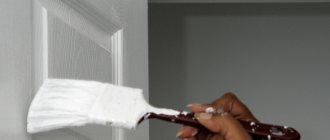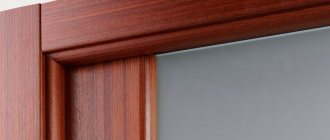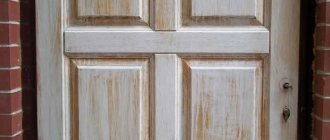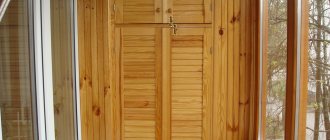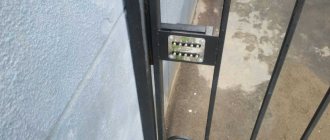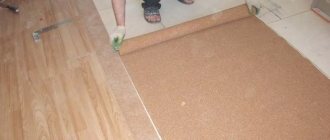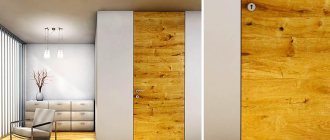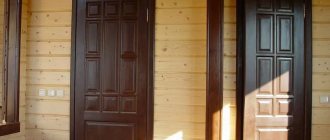Miscellaneous
The decorative covering of a door deteriorates over time and loses its attractiveness. If the old paint is cracked and peeling in places, it is recommended to remove the old coating before applying a new coat. But it also happens that the surface has only lost its shine, has become dull, or spots have appeared on it, but the layer itself lies smoothly and has retained its integrity. In such cases, there is no point in carrying out work to remove the old coating. It will not be possible to qualitatively remove the old layer of paint that has retained its strength. It is difficult to remove. As a result, you can only damage the doors or get a surface whose quality is much lower than the original version.
Features of painting over an old layer
At first glance, painting a wooden door over an old layer seems like a trivial matter: just go ahead and paint it.
Painting the door
But in fact, in order to paint a wooden door and get a surface that will be no worse in quality than factory painting, learn a few rules:
- The surface of the door, regardless of its condition, must be carefully prepared. Against the background of the old paint, cracks and potholes are invisible, but after applying a new layer they will appear and ruin all your efforts.
- The right choice of material for painting an interior door. It’s not just a matter of proper selection of color, surface texture or the strength of the film formed. It is important to consider the compatibility of materials. Many paints are not compatible with each other, and if chosen incorrectly, the old coating may curl or bulge when it comes into contact with the new material.
- Decide on the correct paint application technique. For doors with a complex structure, it is possible to obtain a smooth and neat surface with proper selection and combination of painting techniques and painting tools.
The last rule, common to all cases of working with paint, is to strictly follow the instructions for applying the selected paint material.
Required Tools
Before you begin painting the door, you should prepare the necessary tools and materials. The list is like this:
- supports for laying the canvas (trunks, stools, etc.);
- painting tray and roller (spray gun);
- moderately sharp spatula;
- rags, sponge or rags;
- a set of sandpaper of different grain sizes;
- masking tape;
- set of brushes;
- vacuum cleaner;
- screwdriver or set of screwdrivers;
- primer;
- solvent;
- paint and varnish products (paint, varnish, impregnation, etc.);
- putty;
- protective gloves.
It is best to carry out painting work outside, rather than in a residential apartment, to ensure the safety of its residents.
Which paint to choose
First, decide what paints are used to apply to the door:
- Alkyd enamels. This is the most affordable option. Film strength is average. The advantages include a large range of colors and compatibility with MDF, fiberboard and wood. The main disadvantage is the long drying time and the characteristic pungent odor. Among materials of this type there are a large number of glossy coatings.
- Acrylic enamels. This type of paint is a water dispersion of acrylates. The main advantage over other compositions is the absence of odor and quick drying. In addition, the color palette, represented by hundreds of colors, allows you to create unique shades yourself. To protect the surface, it is additionally coated with parquet transparent varnish.
- Oil-based tinting paints are great for transforming interior and entrance doors. Absorbing into the wood texture they give it a unique shade. The only condition for their use is wood, without any coating.
Variety of paints and varnishes
- Nitro enamels. They dry quickly, but at the same time the volatile, caustic solvent evaporates, which can cause poor health and even poisoning. If you take precautions and use personal protective equipment when working, then this option deserves attention. After the solvent has completely evaporated, the coating becomes safe. It is considered a high-quality and fast method of painting.
- Colored varnishes, glazes. These materials are used for painting varnished door panels. Used in cases where there are no significant cracks or chips on the base. To fully restore the varnished surface, the old varnish must be removed, or you can refuse to re-varnish and paint over the interior doors after puttying.
How to quickly putty?
The surface of the door is puttied if cracks, chips and other defects (pits from knots, etc.) appear on it. With the help of the material, the surface will acquire a smooth and even appearance. You can process the door completely or only certain places.
To complete the work you will need:
- putty;
- putty knife;
- sandpaper.
The puttying procedure is quick and simple:
- clean the sanded surface of the door and prime it;
- mix the putty until the structure is homogeneous;
- Use a spatula to take a small amount of material. Place it slightly above the defective area and move it down, carefully remove the excess;
- If there is a deep crack, do not fill it at once. Apply the putty in two approaches, the second layer after the first has dried;
- Treat the surface of the door with sandpaper after the material has completely dried.
For wooden surfaces, use acrylic or water-based putties.
Material Compatibility
It is not so easy to understand the modern variety of materials. Chemical compositions for the uninitiated person are a secret behind seven locks, and when buying a material to apply to old paint, many rely on luck, hoping that the old layer will not react in any way to contact with the new chemical. There are some recommendations according to which you should select the material depending on what the door is painted with.
Variety of colors
Therefore, before you go for paint, you need to clarify what the canvas is painted with.
- Epoxy and polyurethane compounds contain aggressive solvents. Cyclohexanone or xylene are capable of destroying materials that are reversible polymers obtained by natural curing (nitrocellulose, vinyl, copolymer-vinyl chloride compounds). Simply put, epoxy or polyurethane paint will destroy the coating made with nitro paints.
- Epoxy and polyurethane materials are applied only over the same compositions or primers, maintaining drying intervals for each layer.
- Silicate compounds are generally not applied over any other types of paints.
- Alkyd paints are not aggressive and can be safely applied over any material.
- Copolymer-vinyl chloride compounds and compounds based on chlorine rubber are applied only over acrylic, epoxy, and silicate materials.
Important! To update the door, it is better to use paint of the same type as the previous layer.
Compatibility table
Despite the recommendations of the material compatibility table, it is better to use an experimental test: apply the new material to a small area of the canvas and see the reaction.
Process sequence
In order to paint an interior door with your own hands, you need to complete the work in several stages. Experts recommend carrying out this work in rooms with closed windows, ventilating if necessary. In addition to paint, restoration requires a set of tools: sandpaper, spatula, sponge, putty, solution for removing the old coating. You will also need construction tape, primer, brushes, rollers, a screwdriver, paint containers, and a ladder.
The paint should be prepared according to the instructions. Then the decorative elements are covered with a paint brush and the enamel is applied to the surface. It is better to paint the door leaf with a roller, as brushes leave streaks. After applying the enamel, the door should be thoroughly dried. If necessary, you can paint the surfaces in stages in several layers. It is recommended to remove the masking tape after the surface has completely dried. The final stage: after installing the handles, locks, and latch, the door leaf is hung on the hinges.
Common mistakes
When repairing interior doors, mistakes are made that can ruin the result. Defects missed during inattentive inspection of the surface will appear on the surface. If the artist did not remove oil stains from the surface before applying fresh enamel, streaks will appear on the fresh paint. To avoid this, it is necessary to treat the door with a solvent or acetone, then work on priming the surface. The primer is selected for the appropriate type of paint.
Before painting, you need to thoroughly clean the room of debris and dust. Even small specks of dust and fluff will create unevenness when painting the surface. It would be a mistake to paint without a respirator and special clothing necessary for the safety of the master.
The work is carried out with the windows closed, however, experts advise ventilating the room when painting large surfaces, since enamels, even odorless ones, emit harmful substances. Don't rush when painting: even quick-drying paint needs to dry. The time required for this is indicated on the packaging.
DIY wood door painting
Plain standard doors can be transformed by painting the product to resemble natural wood. To tint the surface, paints of two colors are required: primary and secondary. An imitation of the oak surface is created with a combination of light brown and chocolate shades, the wenge color is created with dark red and black paints.
First, the main tone is applied, after drying, artificial abrasions are made on it using sandpaper. The door is then coated with an additional shade of paint. After painting, the surface is dried and varnished. There are options for transparent varnishes or those creating the effect of aged wood.
Features of working with different surfaces
If the old door looks good, but the coating has only faded and worn out, then it can be quickly updated by such an event as painting the door without removing the previous layer. The tactics of work will depend on the type of coating available:
Painted doors
This option will cause the least amount of trouble with preparation and has every chance of getting a high-quality surface. To paint interior doors with your own hands, just thoroughly wash the surface of the door to remove dirt and grease stains, and fill all cracks and gaps with putty. It is better to take automotive epoxy paints with a hardener. Such putties do not shrink when dry, and all defects can be repaired in one go.
After the putty has dried, the surface is sanded with fine (120 grit) sandpaper. It is better to use a vibrating sander on large flat surfaces (counters, panels). The main task when working with a painted door is high-quality painting, which is achieved by applying several uniform layers of material. The duration of the work will directly depend on the time it takes for the next painted layer of the door to completely dry.
Old painted door
Lacquered doors
If you decide to renew the varnish surface by applying a new layer, it should be taken into account that all defects will remain visible.
Important! Secondary varnishing rarely gives the expected results. As a rule, the surface should be close to ideal. If you don’t want to tinker with the old coating, then it’s better to paint varnished interior doors that have lost their appearance or coat them with a tinted glaze.
The main difficulty in this situation is selecting putty to match the base material. But the wooden surface is not monochromatic in nature. Even if you spend a lot of time and use several shades of putty, you will still end up with stains on the canvas.
Imitation of natural wood
To repaint interior doors in an apartment, it is not always enough to simply apply several layers of paint. Sometimes you want to see the natural pattern of wood on the surface of the canvas. If your doors are made of MDF or lined with regular plywood, they can be painted to imitate natural wood. There are two methods on how to do this.
Option one
The door leaf is coated with light-colored paint. It is recommended to choose gray, beige or yellowish undertones. When the layer is completely dry, apply liquid soap with a wide brush. A layer of darker paint is applied on top (you can choose dark brown or a “wenge” color). Excess liquid soap will begin to appear through this layer - it should be washed off. The result is a coating with a wood fiber pattern.
Option two
First, the door is covered with paint of one color (also light), after drying, a second layer of darker paint. Take a special brush with a textured surface (it can be purchased at any hardware store) and run it over the still damp surface. This is how lines and curls spontaneously appear, which together give an imitation of a wood pattern. After drying, the decorative layer is sanded to give it a natural look and varnished.
As you can see, there are different ways to paint doors at home. Correctly selected coloring composition and adherence to technology will allow you to obtain a high-quality, durable and aesthetically attractive coating. The choice of color and decor of interior doors is a matter of taste.
A simple technology for painting a door for three pennies (1 video)
Coloring options (50 photos)
Door painting technologies
The quality of the door coating depends on the tool, application method and professional skills of the craftsman.
Tools
Door painting is done using the following tools:
- Brushes. It is not recommended to paint the entire canvas with just one brush. If you lack experience, the surface will end up with streaks. It will not be possible to apply a thin, even layer of paint with a brush. But without this tool it will not be possible to paint hard-to-reach places, corners, layout patterns or panel margins. Therefore, when painting canvases with a complex configuration, first work with a brush, painting over problem areas.
- Roller. Repainting panel interior doors is done with just a roller. The roller bobbin must be fur, polyamide or polyacrylic. These materials are resistant to most aggressive solvents.
Important! For painting work on door restoration, foam rollers are not used.
Working with a brush
- Compressor (spray gun). A spray bottle will allow you to get an even, thin layer. The result is a perfectly smooth coating. The process of applying paint is much faster than manually.
Related tools you can’t do without:
- gloves;
- paint tray;
- rags;
- masking tape;
- sandpaper;
- putty knife;
- and what you have at your disposal: stools on which you will place the canvas, or sawhorses.
In addition to paint and varnish, prepare putty, primer and solvent.
Preparing the door covering
Well, let's figure it out further, how to paint a door correctly? Preparatory work is carried out according to the following scheme:
- Remove all old coating, even primer and putty, until the wood itself remains. For this work, you can use a grinder, a hair dryer, or special cleaning compounds.
- Then you need to sand the surface, remove any defects, sand off small paint residues, and degrease. This work cannot be done without a sander, which is best connected to a vacuum cleaner. If you don’t have such a device, you can get by with medium-grain sandpaper.
Plastering a door
- When you have completely managed to sand the canvas and prime it, you can move on to puttying large flaws. If you plan to use varnish as a finishing coat, it is better to use a special composition for wood. If the decorative dye is not transparent, you don’t have to worry about the color of the putty. Don't forget about the gaps at the walls and baseboards!
- After puttying, after waiting the time specified by the manufacturer of the mixture, you need to sand again, masking the abrasions. You can immediately use a medium-grained cloth, and then finish with a fine-abrasive one.
Please note that if there are large dents on the surface and you plan to use an opaque or dark material for the finishing layer, use auto putty. This mixture does not contain glass fibers.
If the doors under the old finishing materials have darkened, and you would like to simply open them with varnish, preserving the structure and pattern of the wood, problem areas can be lightened. To do this, you can prepare a simple bleach with your own hands: mix bleach with water in a ratio of 1:3. When the surface is completely processed, wiped with a rag and dried (so that the paint does not begin to swell), you can begin directly painting the door.
Painting schemes
First, a little theory. The interior door can be panel or panel. Depending on this, the execution scheme and the order of staining will depend.
If it is a panel-type canvas, then painting is carried out in 3 stages:
- Coloring begins from the upper corner in the transverse direction. The movement of the brush goes from left to right.
- the second layer of paint is applied in the longitudinal direction.
- the third layer is similar to the first.
Please note that three layers cannot be applied at once; after each coating, time must pass for the composition to dry.
For work, it is better to use a roller, as the brush may leave streaks.
If it is a paneled door, then first all the recesses are painted with a brush, and then the rest of the panel, but with a roller.
Stages of work
All work can be written in the form of the following algorithm:
- It is better to remove the door and twist the fittings. If there is no such possibility (or desire), then handles, hinges, locks and glass are sealed with film and masking tape. It will be difficult to remove the paint. The tape must be removed before the paint dries.
- Washing and drying the door surface.
- Removing peeling areas, filling defects, sanding. Each layer is sanded after complete drying.
- Selecting the type of paint material.
- Applying a primer (paint diluted with the same type of solvent). This will improve adhesion and reduce the likelihood of bleed through putty areas.
- Applying the required number of layers of paint or varnish.
Color selection
When choosing a color for painting doors, you need to focus on the color scheme in the room. The shade should be combined with furniture, walls and floors.
Recommendations for choosing colors:
- for a strict classic interior, the colors of dark and light wood species are suitable;
- for a minimalist style - cool light shades;
- Doors painted with glossy paints of different colors combine with modern style;
- in the high-tech style, doors can be painted in any bright or metallic color;
- The white color of the door will be combined with different interior styles. A light canvas helps to visually enlarge the room;
- the shade of the door should be average between the color of the interior and the floor covering;
- dark furniture is combined with a door several shades lighter;
- each side of the door can be painted in different shades if the color scheme in the rooms is very different;
- It is better to paint solid wood doors with clear varnish. It will emphasize the natural beauty of the wood pattern;
- in a children's room, the canvas can be painted in bright shades or combined several colors;
- Soft light colored doors are suitable for the bedroom.
Interior doors will look beautiful if they are painted cream, pale pink, or light green. Their shade can be emphasized with the help of accessories: curtains, sofa cushions, curtains.
Useful tips for beginners
For ease of work and control over dipping the tool into paint, use a paint tray.
After purchasing the brushes, it is recommended to comb them out a little and soak them in water for a while. Firstly, this will prevent fallen hairs from reaching the surface, and secondly, it will soften the stubble before work.
It is more convenient to paint the canvas if it is located in a horizontal position. This way you won’t get unsightly streaks if there is too much paint in the corners and sides of the door leaf. Many people use specially prepared sawhorses for convenience, or take the easier route and place the door on 4 stools.
Protection of fittings from smudging. This is not a whim, but a reasonable step. It is advisable to twist it and put it aside for the duration of the work, but an option to protect it is also suitable, for which it is recommended to use masking tape.
Drips resulting from painting can be easily removed if you use a sponge, and then hide its traces by going over the area with a roller.
While the painted canvas is drying, make sure that no accidental dust gets on it or that a stray midge does not stick to it. To do this, it is better to do coloring in a special workshop.
Video on how to properly paint entrance blocks in a house or apartment:
You can update interior or entrance doors in different ways. Painting without removing the old layer is the easiest and fastest method, which home craftsmen most often resort to. The result of the work: a beautiful door without much effort!
Voted over 169 times, average rating 4.6
Comments
Ira 01/30/202015:56 It’s better not to paint interior doors. the paint will stink for a long time
Grade
Add a comment Cancel reply
We recommend reading
Miscellaneous Interesting glass decoupage technique, DIY door decoration Do you want to update the decor of your favorite room, but don’t want to start again...
Miscellaneous Recommendations from professionals on choosing a door frame for interior doors To install a door, you will need to choose the right door…
Miscellaneous Main distinctive characteristics of moldings for interior doors Manufacturers offer door designs of standard sizes, ...
Miscellaneous What is the purpose of installing brushes on interior doors? To make using the interior door convenient and not separate...
Exclusive decor
Painted canvases can be given an original and unique design using exclusive decor. For this you can use:
- Wallpaper. Various types of wallpaper are used for decoration: fabric, vinyl, photo wallpaper and others. With their help, you can highlight individual areas.
- Fabrics: silk, velvet, cambric, voile, etc. Using drapery you can create original designs on the doors.
- Painting horizontal or vertical stripes and lines with paint.
- Baguettes and moldings made of wood, foam. With their help, you can highlight zones on the door, highlight its color and the design of the room.
- Glass and metal inserts.
- Application of original patterns and designs using stencils, which can be purchased in the store or come up with your own individual design.
You can decorate the door together with the children. To fix colorful patterns, apply a layer of varnish. The original decor is well suited for a children's room.
